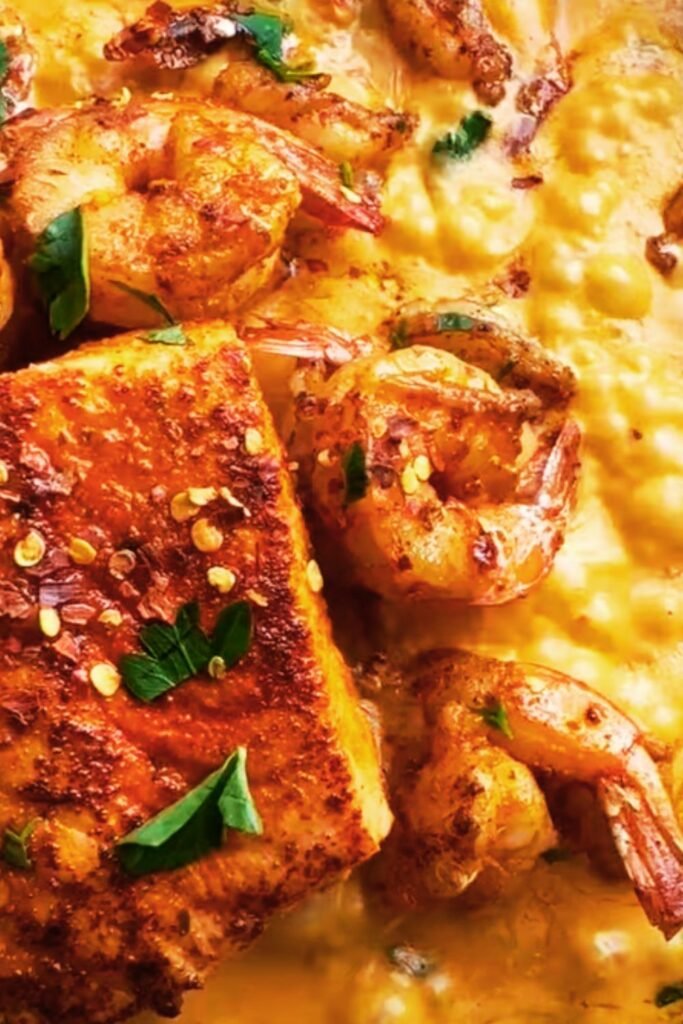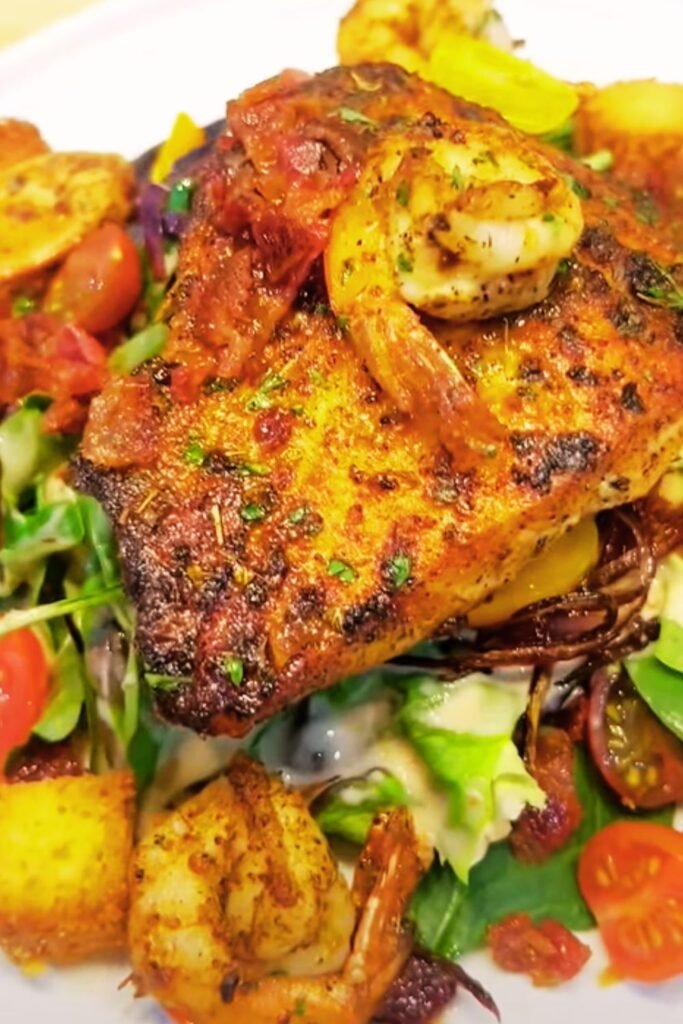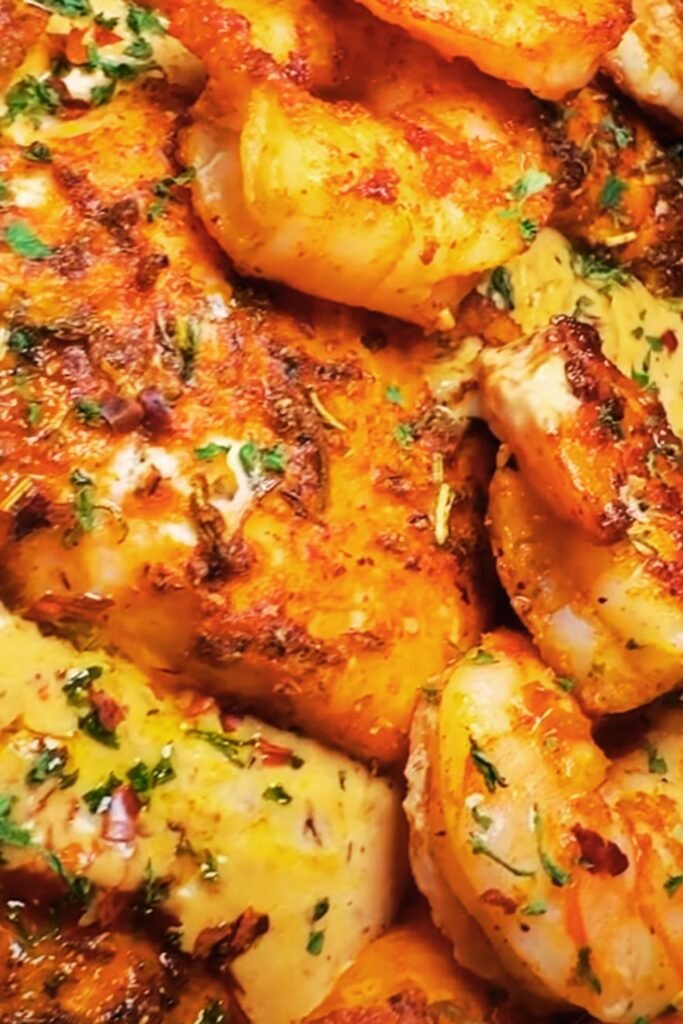There’s something magical about the moment Cajun spices hit a hot skillet. That distinctive sizzle, the eruption of aromas – paprika, thyme, oregano, garlic – all announcing that something extraordinary is about to happen. I’ve been perfecting my Cajun salmon and shrimp recipe for years, and I’m thrilled to finally share my secrets for this show-stopping dish that combines the best of Southern Louisiana flavors with premium seafood.
Cajun cuisine holds a special place in my heart. Growing up near the Gulf Coast, I learned early on that seafood isn’t just food – it’s a celebration, a gathering point, a way to honor the bounty of the waters. This Cajun salmon and shrimp recipe captures that spirit perfectly, bringing together tender salmon fillets and plump shrimp with a spice blend that delivers just the right amount of heat without overwhelming the delicate seafood flavors.
What Makes Cajun Cuisine Special?
Before diving into the recipe, let’s take a moment to appreciate what makes Cajun cooking so unique. Originating from the French-speaking Acadian settlers who relocated to Louisiana after being expelled from Canada in the 18th century, Cajun cuisine is characterized by:
- Bold Spices: The famous “holy trinity” of bell peppers, onions, and celery forms the foundation, complemented by garlic, paprika, cayenne, thyme, and more
- Resourcefulness: Making the most of available ingredients, often incorporating what’s fresh and local
- One-pot Tradition: Many classic Cajun dishes evolved as one-pot meals that could feed large families
- Seafood Prominence: Given Louisiana’s coastal location, seafood features heavily in authentic Cajun cooking
My Cajun salmon and shrimp recipe honors these traditions while adding a few modern touches for convenience and enhanced flavor. Let’s get cooking!
Essential Ingredients for Perfect Cajun Salmon and Shrimp
For the Cajun Seasoning:
- 2 tablespoons paprika (preferably smoked)
- 1 tablespoon garlic powder
- 1 tablespoon onion powder
- 1 tablespoon dried oregano
- 1 tablespoon dried thyme
- 1-2 teaspoons cayenne pepper (adjust according to your heat tolerance)
- 1 tablespoon freshly ground black pepper
- 1 tablespoon kosher salt
- 1 teaspoon brown sugar (my secret ingredient that balances the heat)
For the Seafood:
- 4 salmon fillets (6 oz each), skin-on, preferably wild-caught
- 1 pound large shrimp (16-20 count), peeled and deveined with tails on
- 3 tablespoons high-quality olive oil
- 4 tablespoons unsalted butter
- 4 cloves garlic, minced
- 1 lemon, half juiced and half cut into wedges for serving
For the Creamy Cajun Sauce:
- 1 cup heavy cream
- 1/4 cup chicken broth
- 1/2 cup freshly grated Parmesan cheese
- 2 tablespoons Cajun seasoning (from your homemade blend)
- 1 tablespoon fresh parsley, finely chopped
- 1 teaspoon lemon zest
For Serving:
- 2 green onions, thinly sliced
- Extra fresh parsley, chopped
- Steamed vegetables of your choice (I prefer asparagus or broccoli)
- Steamed rice or creamy stone-ground grits

Equipment You’ll Need
Having the right tools makes this recipe even easier to prepare:
- Large cast-iron skillet (my preference for the perfect sear)
- Fish spatula
- Mixing bowls (various sizes)
- Measuring spoons and cups
- Sharp chef’s knife
- Cutting board
- Small saucepan (for the sauce)
- Whisk
- Paper towels
Making the Perfect Cajun Seasoning Blend
The heart and soul of this dish is the Cajun seasoning blend. While you could use store-bought options, I strongly recommend making your own. The difference is noticeable, and you can adjust the heat level to your preference.
- Combine all seasoning ingredients in a small bowl
- Mix thoroughly until well blended
- Store any unused seasoning in an airtight container for up to 3 months
This recipe makes about 1/2 cup of Cajun seasoning, more than you’ll need for this dish. I always make extra because it’s fantastic on everything from roasted potatoes to grilled chicken.
Preparing the Seafood
Proper preparation of your seafood is crucial for the best results:
For the Salmon:
- Remove salmon fillets from refrigerator 20 minutes before cooking to bring to room temperature
- Pat dry thoroughly with paper towels (this is essential for a good sear)
- Season the flesh side generously with about 1 tablespoon of the Cajun seasoning blend, pressing it in gently
- Drizzle with 1 tablespoon olive oil to help the seasonings adhere
For the Shrimp:
- Ensure shrimp are peeled and deveined but keep the tails on for presentation
- Pat dry with paper towels
- In a medium bowl, toss shrimp with 1 tablespoon olive oil and 1-2 tablespoons of Cajun seasoning until evenly coated
- Let marinate for 10-15 minutes while you prepare other components
The Perfect Cooking Method
Searing the Salmon:
- Heat a large cast-iron skillet over medium-high heat until very hot (about 2 minutes)
- Add 1 tablespoon olive oil and swirl to coat the pan
- Place salmon fillets skin-side down in the hot pan
- Sear undisturbed for 4-5 minutes until the skin is crispy and the salmon is cooked about 3/4 of the way up the sides
- Flip carefully using a fish spatula and cook for another 1-2 minutes
- Remove salmon from the pan and set aside on a warm plate, covering loosely with foil
Cooking the Shrimp:
- In the same skillet (don’t clean it – those salmon bits add flavor!), add 2 tablespoons of butter
- Once butter is melted, add the seasoned shrimp in a single layer
- Cook for 2 minutes, then flip and cook for another 1-2 minutes until just pink and opaque
- Add minced garlic during the last minute of cooking
- Squeeze half a lemon over the shrimp
- Remove shrimp and set aside with the salmon
Creating the Creamy Cajun Sauce
The sauce brings everything together and elevates this dish from great to extraordinary:
- Reduce heat to medium-low
- Add remaining 2 tablespoons butter to the same skillet
- When melted, add heavy cream, chicken broth, and 2 tablespoons of your Cajun seasoning
- Whisk continuously as the sauce comes to a gentle simmer
- Cook for 3-4 minutes until slightly thickened
- Add Parmesan cheese, whisking until melted and incorporated
- Stir in lemon zest and fresh parsley
- Taste and adjust seasoning if needed
Bringing It All Together
Now for the grand finale – assembling your masterpiece:
- Return salmon fillets to the skillet, placing them skin-side up in the sauce
- Add the cooked shrimp around the salmon
- Spoon sauce over everything and let simmer for 1-2 minutes to reheat and allow flavors to meld
- Garnish with sliced green onions and additional fresh parsley

Serving Suggestions
This versatile dish pairs beautifully with several sides:
- Creamy Stone-Ground Grits: The ultimate Southern complement to seafood
- Steamed Jasmine Rice: Perfect for soaking up the delicious sauce
- Roasted Vegetables: Asparagus, broccoli, or bell peppers work particularly well
- Simple Green Salad: For a lighter option, dressed with lemon vinaigrette
- Crusty French Bread: Essential for not wasting a drop of that sauce!
I personally love serving this with creamy grits and roasted asparagus for a complete meal that always impresses guests.
Nutritional Information
Understanding the nutritional profile of this dish can help you incorporate it into a balanced meal plan:
| Nutrient | Amount (per serving) |
|---|---|
| Calories | 585 |
| Protein | 48g |
| Fat | 38g |
| Saturated Fat | 18g |
| Carbohydrates | 8g |
| Fiber | 1g |
| Sugar | 2g |
| Sodium | 1250mg |
| Cholesterol | 285mg |
| Omega-3 Fatty Acids | 1800mg |
Note: Nutritional values are approximate and calculated without side dishes.
Make-Ahead and Storage Tips
This dish is best enjoyed fresh, but you can prepare components ahead of time:
- Cajun Seasoning: Can be made weeks in advance and stored in an airtight container
- Prepping Seafood: Can be seasoned up to 4 hours before cooking (keep refrigerated)
- Leftovers: Store in an airtight container for up to 2 days in the refrigerator
- Reheating: Gently warm in a skillet over low heat, adding a splash of cream if the sauce has thickened too much
Adjusting for Dietary Needs
This recipe can be modified to accommodate various dietary requirements:
Dairy-Free Version:
- Replace butter with olive oil or ghee
- Substitute coconut cream for heavy cream
- Omit Parmesan cheese and add 1 tablespoon nutritional yeast for a cheesy flavor
Lower-Carb Option:
- Serve with cauliflower rice instead of regular rice or grits
- Increase the portion of vegetables
Milder Version:
- Reduce cayenne pepper to 1/4 teaspoon in the Cajun seasoning
- Add an extra tablespoon of brown sugar to the seasoning blend
Common Mistakes to Avoid
Even experienced cooks can benefit from these reminders:
- Not patting seafood dry: This prevents a good sear and can result in steaming rather than searing
- Overcooking the seafood: Both salmon and shrimp continue cooking off the heat, so remove them just before they’re fully done
- Skipping the room temperature step for salmon: Cold fish in a hot pan can lead to uneven cooking
- Disturbing the salmon while it sears: Let it develop that crust before attempting to flip
- Overcrowding the pan: Cook in batches if necessary to maintain proper heat

Variations to Try
Once you’ve mastered the basic recipe, consider these delicious variations:
Blackened Cajun Seafood:
- Increase the heat when searing to achieve a darker, more intensely flavored crust
- Add 1 teaspoon of ground coffee to your Cajun seasoning for depth
Cajun Seafood Pasta:
- Prepare the recipe as directed
- Toss with 12 ounces of cooked fettuccine or linguine before serving
- Add 1/2 cup pasta cooking water to the sauce to help it adhere to the pasta
Cajun Seafood Bowl:
- Serve over a base of half rice, half roasted vegetables
- Add sliced avocado and a drizzle of lime crema
- Sprinkle with crispy fried shallots for texture
A Note on Sustainable Seafood
As someone who values our ocean resources, I always recommend choosing sustainably sourced seafood:
- Look for wild-caught Alaskan salmon when possible
- Choose shrimp certified by the Marine Stewardship Council or labeled as sustainably farmed
- Ask your fishmonger about the origin of your seafood
- Consider using the Seafood Watch app to make informed choices
By selecting sustainable options, we ensure that this delicious recipe can be enjoyed for generations to come.
The Perfect Wine Pairing
While this dish stands beautifully on its own, the right beverage can enhance the experience:
- Sparkling Water: With a slice of lemon or lime, refreshes the palate between bites
- Sweet Tea: A Southern classic that balances the spice perfectly
- Lemonade: The acidity cuts through the richness of the cream sauce
Q&A Section
Q: Can I use frozen seafood for this recipe? While fresh is always preferable, you can use frozen seafood with good results. For salmon, thaw completely in the refrigerator overnight and pat very dry before seasoning. For shrimp, thaw under cold running water and pat dry thoroughly. You may need to reduce cooking time slightly as frozen seafood sometimes cooks more quickly after thawing.
Q: How can I tell when the salmon is perfectly cooked? The perfect salmon should be firm but still slightly translucent in the center. When you press the thickest part with a fork, it should flake easily but still look moist. For medium doneness (my recommendation), the internal temperature should reach about 125-130°F (52-54°C). Remember that it will continue cooking slightly after being removed from heat.
Q: My sauce broke and looks curdled. What happened? This typically occurs when the heat is too high or the cream is added to a very hot pan. To fix a broken sauce, remove from heat, add a tablespoon of cold heavy cream, and whisk vigorously. You can also try transferring to a blender for a few seconds. To prevent breaking, always reduce heat before adding cream and avoid boiling the sauce.
Q: What can I substitute for heavy cream to make this lighter? You can use half-and-half or whole milk mixed with 1 tablespoon of cornstarch (mixed into a slurry first). For a dairy-free option, full-fat coconut milk works surprisingly well with the Cajun flavors. The sauce won’t be quite as rich but will still be delicious.
Q: Is there a way to make this dish ahead for a dinner party? Yes! Prepare the Cajun seasoning and season the seafood up to 4 hours ahead, keeping refrigerated. You can also prep all vegetables and sides in advance. About 20 minutes before serving, cook the seafood and make the sauce. This dish comes together quickly once you start cooking, making it perfect for entertaining.
Q: How spicy is this recipe as written? As written with 1-2 teaspoons of cayenne, this recipe has a moderate heat that builds pleasantly. If you’re sensitive to spice, start with 1/4 teaspoon of cayenne and adjust from there. Remember that the cream in the sauce helps temper the heat considerably.
Q: Can I use other fish instead of salmon? Absolutely! This recipe works beautifully with any firm, white fish like halibut, mahi-mahi, or red snapper. Adjust cooking times based on thickness – thinner fillets will cook more quickly than salmon. For a truly indulgent version, try it with sea bass.
Q: My shrimp turned out rubbery. What went wrong? Shrimp cook extremely quickly and continue cooking from residual heat. They’re done as soon as they turn pink and opaque, usually just 2-3 minutes total. Watch them carefully and remove from heat immediately when they’re just barely done. Starting with larger shrimp (16-20 count) also helps prevent overcooking.
Final Thoughts
My Cajun salmon and shrimp recipe bridges the gap between everyday cooking and special occasion fare. It’s sophisticated enough for entertaining but simple enough for a weeknight when you want something extraordinary. The combination of tender salmon, succulent shrimp, and that velvety, spice-infused sauce creates a symphony of flavors that celebrates the best of Southern cooking.
I encourage you to make this recipe your own. Perhaps add a touch more heat if you like things spicy, or experiment with different herbs in the sauce. Cooking is about personal expression, and the best recipes evolve as they’re shared and adapted.
Whatever adjustments you make, focus on quality ingredients, especially the seafood. The freshest salmon and shrimp will always yield the best results, transforming this good recipe into something truly memorable.
Happy cooking, and laissez les bons temps rouler – let the good times roll!